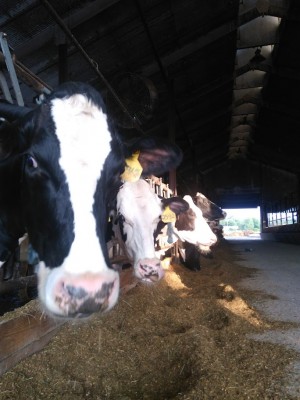Natural cow instincts lead to bunching - Hoard`s Dairyman

Natural cow instincts lead to bunching - Hoard`s Dairyman
by Abby Bauer
Standing tightly together or "bunching" is not a new behavior in cows, but it is one that is frustrating for many dairy farmers. It is not uncommon that, even in a barn with plenty of space and air flow, cows will group together and seem to only live in half the barn during the summer months.
The reason for this, according to University of Wisconsin-Madison veterinarian Nigel Cook, is that cows are by nature pasture animals. "When they are heat stressed or worried by flies, the natural reaction for cows is the come together and seek shade," Cook said during a Dairyland Initiative "Assessing adult cow barn ventilation" workshop.
"That instinct to group together and go somewhere dark is still strong," he continued. For cows housed indoors, that often means moving away from side walls and end walls and gathering in the middle of the barn. Cook noted that this can be more common in barns oriented north to south. In some situations, the cows could also be seeking out areas with faster moving air.
This is a problem because when cows are bunched together, they are not cooling. "Cows naturally dissipate heat when they stand," Cook explained, as a standing cow has greater surface area for air movement to aid in cooling. "That is not happening when cows are all confined together in a packed space," he noted.
To reduce bunching in dairy barns, Cook offered a few pieces of advice. For starters, a facility should have proper heat abatement in place, in the form of fans and sprinklers. This is important for both the holding area and the barn.
He said to close up end walls and avoid using transparent siding on ends of the barns, because this allows in more light and increases the variability of light intensity in the pen. Curtains can also be partially closed on sunny days to prevent bright areas in the barn.
Spraying for flies is helpful to reduce that nuisance, and again, it is important to ensure sufficient air exchange and cooling to prevent cows from feeling heat stressed in the first place.
Cook also reminded the audience that cows accumulate heat throughout the day. For this reason, their peak in body temperature and maximum heat stress does not occur at the same time at peak ambient temperature. Cows may not reach their highest body temperature until 6 p.m. to 10 p.m. at night.
Unfortunately, this poses a problem for many heat abatement systems that are set to run on a thermostat. "We often turn everything off just when actually we need to turn it on," Cook said. This should be kept in mind when setting the controls for cow cooling to minimize the effects of heat stress late in the day.
Upcoming Events
Crops, Cows & Critters - Southwest New York Dairy, Livestock & Field Crops Newsletter Sponsorship
December 19, 2025
Our two forms of publications feature research-based and timely information from our four specialists, listed to the right, along with local event notifications and Cornell University outreach. This information is provided to participants who range from dairy, livestock, and field crops producers to agricultural suppliers and consultants.
Weekly Email Update: Shared with 625+ households who have signed up with our program.
Monthly Paper Mailer: To reach our stakeholders and farmers who lack internet access, we send out a monthly mailer where your company's logo and contact information would be featured with a mailing list of 330+ households.
If you sponsor our weekly and monthly publications you reach approximately 955 households.
Visit our website to view our newsletters!
2025 Cornell Food Beverage & Animal Feed Manufacturer Survey
December 19, 2025
Industry and Educational Advocates for New York State's Food, Beverage, and Animal Feed Manufacturing industries:
As you know, NYS has a diverse food and beverage manufacturing industry, in both the types of industries that exist and the wide distribution of firms by scale. Many manufacturing firms have strong backward linkages to agricultural production sectors in the state that support both farm-level and downstream food industry firms and consumers. In collaboration with the New York State Department of Agriculture and Markets, a team from Cornell University's Charles H. Dyson School of Applied Economics and Management has recently rolled out the 2025 New York State Food, Beverage, and Animal Feed Manufacturer Survey. The industry will benefit from an updated assessment of the industry that informs private and public investments and opportunities to support firm growth and improved profitability.
Cornell Organic Field Crops & Dairy Conference
March 6, 2026
Waterloo, NY
Farmers, researchers, educators, and agricultural service providers from across the Northeast are invited to the 2026 Cornell Organic Field Crops & Dairy Conference, held Friday, March 6, 2026, from 8:00 a.m. to 4:30 p.m. at the Lux Hotel & Conference Center in Waterloo, N.Y.
Co-hosted by New York Soil Health and Cornell CALS, the annual conference brings together leaders in organic grain, dairy, and livestock systems to share practical tools, new research, and farmer-tested strategies to support resilient and profitable organic production.
Announcements
No announcements at this time.





